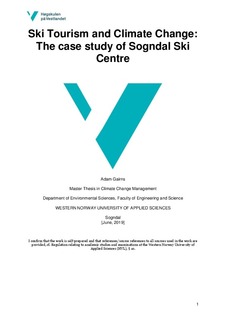| dc.contributor.author | Gairns, Adam | |
| dc.date.accessioned | 2019-09-06T11:28:42Z | |
| dc.date.available | 2019-09-06T11:28:42Z | |
| dc.date.issued | 2019 | |
| dc.identifier.uri | http://hdl.handle.net/11250/2612939 | |
| dc.description | Master Thesis in Climate Change Management Department of Environmental Sciences, Faculty of Engineering and Science [June, 2019] | nb_NO |
| dc.description.abstract | Ski tourism in Norway, a highly snow-dependent industry may be seriously affected by climate change. This thesis shows that Sogndal ski centre (Western Norway) will become a victim from climate change impacts whilst at the same time contributing to those impacts through releasing greenhouse gas emissions. A ski season simulation model SkiSim2.0 was applied to Sogndal ski centre alongside analysing the carbon inventory of their 2017/18 winter season. The model shows that climate impacts under a low emission scenario are negligible, with the ski centre still ensuring over a 100-day season until 2080. Under a high emission scenario, with warming towards 4°C there is a severe reduction in ski season length with the ski centre hovering around the 100-day threshold towards 2080. The Christmas holidays will become particularly sensitive, and after the year 2050, the ski centre may become economically unsustainable. The carbon inventory analysis showed that customer commuting represents 62% of the total 232,889 kg/CO2 emitted for the 2017/18 winter season. SkiSim2.0 model is very good illustration of changes in ski season length but is not reality, therefore the results should be seen as an indicator. The carbon inventory is limited due to the quantity and quality of the data but represents a building block to expand from. Sogndal, a ski centre that specialises in off-piste skiing cannot apply traditional adaptation techniques of snow production to increase season length. This thesis provides an attempt to recommend a preliminary climate change action plan for the ski centre. That uses the theory of sustainable development to introduce short- and long-term strategies that would reduce the carbon footprint of Sogndal ski centre to be in align with Norway’s reduction targets of 40% by the year 2030. It also recommends that a climate change sector is established within the Alpinanleggenese Landsforening (ALF) helping to implement climate change action plans and emission reduction targets throughout all ski centres in Norway. | nb_NO |
| dc.language.iso | eng | nb_NO |
| dc.publisher | Høgskulen på Vestlandet | |
| dc.rights | Navngivelse 4.0 Internasjonal | * |
| dc.rights.uri | http://creativecommons.org/licenses/by/4.0/deed.no | * |
| dc.subject | Climate Change | nb_NO |
| dc.subject | SkiSim2.0 | nb_NO |
| dc.subject | Ski Centres | nb_NO |
| dc.subject | Sustainable Development | nb_NO |
| dc.subject | Carbon Inventory | nb_NO |
| dc.subject | Climate Change Action Plan | nb_NO |
| dc.subject | Sogndal ski centre | nb_NO |
| dc.subject | Norwegian ski centres | nb_NO |
| dc.title | Ski Tourism and Climate Change: The case study of Sogndal Ski Centre | nb_NO |
| dc.type | Master thesis | nb_NO |
| dc.source.pagenumber | 66 | nb_NO |

